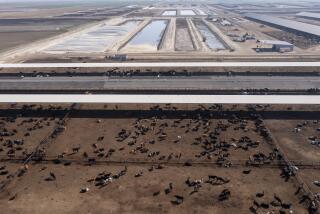The Ever Quieter Country
- Share via
The vast fields sit there like time itself, stretching from county to county and state to state from the Great Lakes clear and flat to the Rockies. This is the expanse many Americans sleep, read or watch movies over while transiting six miles above. Occasionally, pockets of lights glow below--small towns that, according to emerging census data, are getting even smaller as farms get bigger.
The fields, enriched by topsoil sometimes more than 50 feet thick that was delivered by glaciers thousands of years ago, are doing fine. But as chronicled by The Times’ Stephanie Simon recently, the communities every few miles that once served the farm families are troubled. For many towns the brightest light is a Coke machine, with groceries, clinics, stores, even schools closing as the population, especially the young, seeks opportunities elsewhere. The problem isn’t new, just worse.
This is the downside of our restless, disposable society: The rural heartland that produced so many people, inventions, products, stories and values for elsewhere gets hollowed out by economic and social forces beyond its ken.
America’s coastal millions need not pine for small-town life to sense the pain.
Federal crop subsidy programs have long funneled funds to farmers to ensure viable food production; growers’ billion-dollar exports also help the country’s balance of payments.
Now, after Congress has spent huge sums on urban restorations, Sens. Charles Hagel (R-Neb.) and Byron L. Dorgan (D-N.D.), themselves transplanted products of small towns, are proposing a 21st century Homestead Act to reverse the rural drain.
In terms of reproducing economically vibrant small towns and family farms, even local residents don’t foresee success. But there could be useful progress in providing tax breaks for business investments and forgiving student loans for college graduates who move back to provide health care, for instance. Getting this through legislatures dominated by far more populous urban and suburban areas is a tough row to hoe, however.
Still, with today’s technology--computers, e-mail, faxes, 800 numbers--many companies do find a ready, diligent, appreciative and cheaper labor pool in the countryside for data processing and order-taking.
Midwestern farm fields bake in the humid midsummer sun these days, awaiting the next thundershower. Listening closely, you can hear the gentle hum of natural activity as the bees, birds, insects and microbes do their wondrous work developing the next crops of corn, soybeans, wheat, sunflowers and more in the world’s most productive farm region. It’s the nearby towns that have become quiet.
More to Read
Sign up for Essential California
The most important California stories and recommendations in your inbox every morning.
You may occasionally receive promotional content from the Los Angeles Times.













